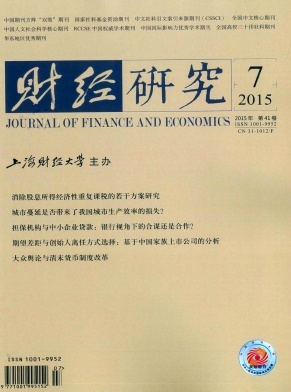基于分类转移的盈余管理研究——来自中国上市公司的经验证据
财经研究 2015 年 第 41 卷第 07 期, 页码:
摘要
参考文献
摘要
以粉饰或掩盖公司真实经济业绩为目的的盈余管理行为一直是学术界关注的重要问题。针对以往研究缺乏对中国上市公司分类转移行为的关注,文章选取2007-2012年沪深两市A股上市公司的财务数据,实证考察了管理层利用线上项目与线下项目之间的分类转移调整公司盈余结构的行为。研究发现:(1)管理层会将经营费用向下转移至营业外支出或将营业外收入向上转移至营业收入,以调增公司的核心盈余;(2)管理层会利用线上项目与线下项目之间的分类转移实现营业利润增长和避免营业利润为负;(3)管理层利用线上项目与线下项目之间的分类转移调增核心盈余的程度随着第一大股东持股比例、独立董事比例和机构投资者持股比例的增大而减少,随着审计质量的提高而增加,并且大股东和独立董事对分类转移操纵的抑制作用仅在非国有企业中得以体现,而机构投资者对分类转移操纵的抑制作用仅在国有企业中得以体现。文章为会计准则制定者、公司治理层以及企业外部审计师审查分类转移操纵提供了借鉴。
[1]蔡春,黄益建,赵莎. 关于审计质量对盈余管理影响的实证研究——来自沪市制造业的经验证据[J]. 审计研究,2005,(2):3-10.
[2]程小可. 中国上市公司盈余结构的业绩预测能力[J]. 经济科学,2005,(4):109-116.
[3]高雷,张杰. 公司治理、机构投资者与盈余管理[J]. 会计研究,2008,(9):64-72.
[4]黄文伴,李延喜. 公司治理结构与盈余管理关系研究[J]. 科研管理,2010,(6):144-150.
[5]蒋义宏,王丽琨. 非经常性损益缘何经常发生——来自亏损上市公司年报的证据[J]. 证券市场导报,2003,(6):9-13.
[6]李仙,聂丽洁. 我国上市公司IPO中审计质量与盈余管理实证研究[J]. 审计研究,2006,(6):67-72.
[7]李延喜,杜瑞,高锐. 机构投资者持股比例与上市公司盈余管理的实证研究[J]. 管理评论,2011,(3):39-45.
[8]陆宇建,蒋玥. 制度变革、盈余持续性与市场定价行为研究[J]. 会计研究,2012,(1):58-67.
[9]钱爱民,张新民,周子元. 盈利结构质量、核心盈利能力与盈利持续性——来自我国A股制造业上市公司的经验证据[J]. 中国软科学,2009,(8):108-118.
[10]孙亮,刘春. 公司治理对盈余管理程度的制约作用——以所有权性质为背景的经验分析[J]. 金融评论,2010,(3):65-72.
[11]王福胜,吉姗姗,程富. 盈余管理对上市公司未来经营业绩的影响研究——基于应计盈余管理与真实盈余管理比较视角[J]. 南开管理评论,2014,(2):95-106.
[12]魏涛,陆正飞,单宏伟. 非经常性损益盈余管理的动机、手段和作用研究——来自中国上市公司的经验证据[J]. 管理世界,2007,(1):113-121.
[13]杨晋渝,刘斌,孙立. 盈余管理、高管薪酬敏感度和股权结构[J]. 重庆大学学报(社会科学版),2013,(2):70-76.
[14]张兆国,刘晓霞,邢道勇. 公司治理结构与盈余管理——来自中国上市公司的经验证据[J]. 中国软科学,2009,(1):122-133.
[15]张子余,张天西. “特殊损失项目”与“核心费用”之间的归类变更盈余管理研究[J]. 财经研究,2012,(3):70-80.
[16]赵宇龙,王志台. 我国证券市场 “功能锁定”现象的实证研究[J]. 经济研究,1999,(9):56-63.
[17]Barua A, Lin S, Sbaraglia A M. Earnings management using discontinued operations[J]. The Accounting Review, 2010, 85(5): 1485-1510.
[18]Bradshaw M T, Sloan R G. GAAP versus the street: An empirical assessment of two alternative definitions of earnings[J]. Journal of Accounting Research, 2002, 40(1): 41-66.
[19]Brawn L D, Caylor M L. A temporal analysis of thresholds: Propensities and valuation consequences[J]. The Accounting Review, 2005, 80(2): 423-440.
[20]Cohen D A, Zarowin P. Accrualbased and real earnings management activities around seasoned equity offerings[J]. Journal of Accounting and Economics,2010,50(1):2-19.
[21]Daivs A K. The value relevance of revenue for internet firms: Does reporting grossedup or barter revenue make a difference?[J]. Journal of Accounting Research, 2002, 40(2): 445-477.
[22]Fan Y, Barua A, Cready W M, et al. Managing earnings using classification shifting: Evidence from quarterly special items[J]. The Accounting Review, 2010, 85(4): 1303-1323.
[23]Gunny K A. The relation between earnings management using real activities manipulation and future performance: Evidence from meeting earnings benchmarks[J]. Contemporary Accounting Research, 2010, 27(3): 855-888.
[24]Haw I M, Qi D, Wu D, et al. Market consequences of earnings management in response to security regulations in China[J]. Contemporary Accounting Research, 2005, 22(1): 95-140.
[25]Haw I M, Ho S M, Li A Y. Corporate governance and earnings management by classification shifting[J]. Contemporary Accounting Research, 2011, 28(2): 517-553.
[26]Healy P M, Wahlen J M. A review of the earnings management literature and its implications for standards setting[J]. Accounting Horizons, 1999, 13(4): 365-383.
[27]Jiang J. Beating earnings benchmarks and the cost of debts[J]. The Accounting Review, 2008, 83(2): 377-416.
[28]Lipe R. The information contained in the components of earnings[J]. Journal of Accounting Research, 1986, 24(Supplement): 37-64.
[29]Matsunaga S R, Park C W. The effect of missing a quarterly earnings benchmark on the CEO’s annual bonus[J]. The Accounting Review, 2001, 76(3): 313-332.
[30]McVay S E. Earnings management using classification shifting: An examination of core earnings and special items[J]. The Accounting Review, 2006, 81(3): 501-531.
[31]Nelson M, Eilliontt J, Tarpley R. Evidence from auditors about manager’s and auditor’s earnings management decisions[J]. The Accounting Review, 2002, 77(Supplement): 175-202.
[32]Roychowdhury S. Earnings management through real activities manipulation[J]. Journal of Accounting and Economics, 2006, 42(3): 335-370.
[2]程小可. 中国上市公司盈余结构的业绩预测能力[J]. 经济科学,2005,(4):109-116.
[3]高雷,张杰. 公司治理、机构投资者与盈余管理[J]. 会计研究,2008,(9):64-72.
[4]黄文伴,李延喜. 公司治理结构与盈余管理关系研究[J]. 科研管理,2010,(6):144-150.
[5]蒋义宏,王丽琨. 非经常性损益缘何经常发生——来自亏损上市公司年报的证据[J]. 证券市场导报,2003,(6):9-13.
[6]李仙,聂丽洁. 我国上市公司IPO中审计质量与盈余管理实证研究[J]. 审计研究,2006,(6):67-72.
[7]李延喜,杜瑞,高锐. 机构投资者持股比例与上市公司盈余管理的实证研究[J]. 管理评论,2011,(3):39-45.
[8]陆宇建,蒋玥. 制度变革、盈余持续性与市场定价行为研究[J]. 会计研究,2012,(1):58-67.
[9]钱爱民,张新民,周子元. 盈利结构质量、核心盈利能力与盈利持续性——来自我国A股制造业上市公司的经验证据[J]. 中国软科学,2009,(8):108-118.
[10]孙亮,刘春. 公司治理对盈余管理程度的制约作用——以所有权性质为背景的经验分析[J]. 金融评论,2010,(3):65-72.
[11]王福胜,吉姗姗,程富. 盈余管理对上市公司未来经营业绩的影响研究——基于应计盈余管理与真实盈余管理比较视角[J]. 南开管理评论,2014,(2):95-106.
[12]魏涛,陆正飞,单宏伟. 非经常性损益盈余管理的动机、手段和作用研究——来自中国上市公司的经验证据[J]. 管理世界,2007,(1):113-121.
[13]杨晋渝,刘斌,孙立. 盈余管理、高管薪酬敏感度和股权结构[J]. 重庆大学学报(社会科学版),2013,(2):70-76.
[14]张兆国,刘晓霞,邢道勇. 公司治理结构与盈余管理——来自中国上市公司的经验证据[J]. 中国软科学,2009,(1):122-133.
[15]张子余,张天西. “特殊损失项目”与“核心费用”之间的归类变更盈余管理研究[J]. 财经研究,2012,(3):70-80.
[16]赵宇龙,王志台. 我国证券市场 “功能锁定”现象的实证研究[J]. 经济研究,1999,(9):56-63.
[17]Barua A, Lin S, Sbaraglia A M. Earnings management using discontinued operations[J]. The Accounting Review, 2010, 85(5): 1485-1510.
[18]Bradshaw M T, Sloan R G. GAAP versus the street: An empirical assessment of two alternative definitions of earnings[J]. Journal of Accounting Research, 2002, 40(1): 41-66.
[19]Brawn L D, Caylor M L. A temporal analysis of thresholds: Propensities and valuation consequences[J]. The Accounting Review, 2005, 80(2): 423-440.
[20]Cohen D A, Zarowin P. Accrualbased and real earnings management activities around seasoned equity offerings[J]. Journal of Accounting and Economics,2010,50(1):2-19.
[21]Daivs A K. The value relevance of revenue for internet firms: Does reporting grossedup or barter revenue make a difference?[J]. Journal of Accounting Research, 2002, 40(2): 445-477.
[22]Fan Y, Barua A, Cready W M, et al. Managing earnings using classification shifting: Evidence from quarterly special items[J]. The Accounting Review, 2010, 85(4): 1303-1323.
[23]Gunny K A. The relation between earnings management using real activities manipulation and future performance: Evidence from meeting earnings benchmarks[J]. Contemporary Accounting Research, 2010, 27(3): 855-888.
[24]Haw I M, Qi D, Wu D, et al. Market consequences of earnings management in response to security regulations in China[J]. Contemporary Accounting Research, 2005, 22(1): 95-140.
[25]Haw I M, Ho S M, Li A Y. Corporate governance and earnings management by classification shifting[J]. Contemporary Accounting Research, 2011, 28(2): 517-553.
[26]Healy P M, Wahlen J M. A review of the earnings management literature and its implications for standards setting[J]. Accounting Horizons, 1999, 13(4): 365-383.
[27]Jiang J. Beating earnings benchmarks and the cost of debts[J]. The Accounting Review, 2008, 83(2): 377-416.
[28]Lipe R. The information contained in the components of earnings[J]. Journal of Accounting Research, 1986, 24(Supplement): 37-64.
[29]Matsunaga S R, Park C W. The effect of missing a quarterly earnings benchmark on the CEO’s annual bonus[J]. The Accounting Review, 2001, 76(3): 313-332.
[30]McVay S E. Earnings management using classification shifting: An examination of core earnings and special items[J]. The Accounting Review, 2006, 81(3): 501-531.
[31]Nelson M, Eilliontt J, Tarpley R. Evidence from auditors about manager’s and auditor’s earnings management decisions[J]. The Accounting Review, 2002, 77(Supplement): 175-202.
[32]Roychowdhury S. Earnings management through real activities manipulation[J]. Journal of Accounting and Economics, 2006, 42(3): 335-370.
引用本文
程 富, 王福胜. 基于分类转移的盈余管理研究——来自中国上市公司的经验证据[J]. 财经研究, 2015, 41(7): 0.
导出参考文献,格式为:





 10195
10195  4357
4357

